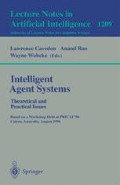Abstract
This paper presents a practical multi-agent architecture for assisting users to coordinate the use of both special and general purpose software tools for performing tasks in a given problem domain. The architecture is open and extensible being based on the techniques of agent-based software interoperability (ABSI), where each tool is encapsulated by a KQML-speaking agent. The work reported here adds additional facilities for the user to describe the problem domain, the tasks that are commonly performed in that domain and the ways in which various software tools are commonly used by the user. Together, these features provide the computer with a degree of autonomy in the user's problem domain in order to help the user achieve tasks through the coordinated use of disparate software tools.
This research focuses on the representational and planning capabilities required to extend the existing benefits of the ABSI architecture to include domain-level problem-solving skills. In particular, the paper proposes a number of standard ontologies that are required for this type of problem, and discusses a number of issues related to planning the coordinated use of agent-encapsulated tools.
Preview
Unable to display preview. Download preview PDF.
References
N. Singh. A Common Lisp API and facilitator for ABSI: version 2.0.3. Technical Report Logic-93-4, Logic Group, Computer Science Department, Stanford University, 1993.
M. R. Genesereth and S. P. Ketchpel. Software agents. Communications of the ACM, 37(7):48–53, July 1994.
Los Alamos National Laboratory Advanced Computing Laboratory. Information resources for CORBA and the OMG. http://www.acl.lanl.gov/CORBA/.
M. R. Cutkosky, R. S. Engelmore, R. E. Fikes, M. R. Genesereth, and T. R. Gruber. PACT: An experiment in integrating engineering systems. Computer, 26(1):28–37, 1993.
T. Khedro and M. Genesereth. The federation architecture for interoperable agent-based concurrent engineering systems. International Journal on Concurrent Engineering, Research and Applications, 2:125–131, 1994.
W. Wong and A. Keller. Developing an Internet presence with online electronic catalogs. Stanford Center for Information Technology, http://www-db.stanford.edu/pub/keller/1994/cnet-online-cat.ps.
T. Nishida and H. Takeda. Towards the knowledgeable community. In Proceedings of the International Conference on the Building and Sharing of Very Large Scale Knowledge Bases, pages 157–166, 1993. http://ai-www.aist-nara.ac.jp/doc/people/takeda/doc/ps/kbks.ps.
S. J. S. Cranefield and M. K. Purvis. Agent-based integration of general-purpose tools. In Proceedings of the Workshop on Intelligent Information Agents, Fourth International Conference on Information and Knowledge Management, December 1995. http://www.cs. umbc.edu/∼cikm/iia/proc.html.
Stanford Knowledge Systems Laboratory. Ontology Server Web page. http://www-ksl-svc.stanford.edu:5915/.
K. Erol, J. Hendler, and D. S. Nau. UMCP: A sound and complete procedure for hierarchical task-network planning. In K. Hammond, editor, Proceedings of the 2nd International Conference on AI Planning Systems, pages 249–254, 1994.
J. Ambros-Ingerson and S. Steel. Integrating planning, execution and monitoring. In Proceedings of the 7th National Conference on Artificial Intelligence, pages 735–740, 1988.
K. Golden, O. Etzioni, and D. Weld. Omnipotence without omniscience: Efficient sensor management for planning. In Proceedings of the 12th National Conference on Artificial Intelligence, pages 1048–1054. AAAI Press, 1994. file://cs.washington.edu/pub/ai/tr94-01-03.ps.Z.
C. A. Knoblock. Planning, executing, sensing, and replanning for information gathering. In Proceedings of the Fourteenth International Joint Conference on Artificial Intelligence, 1995. http://www.isi.edu/sims/papers/95-sage.ps.
M. Williamson, K. Decker, and K. Sycara. Unified information and control flow in hierarchical task networks. In Proceedings of the AAAI-96 Workshop on Theories of Action, Planning and Control, 1996. http://www.cs.cmu.edu/∼softagents/papers/provisions.ps.
P. R. Cohen, A. Cheyer, M. Wang, and S. C. Baeg. An open agent architecture. In Proceedings of the Spring Symposium on Software Agents, Technical Report SS-94-03. AAAI Press, 1994. ftp://ftp.ai.sri.com/pub/papers/cheyer-aaai94.ps.gz.
C. A. Knoblock and J. L. Ambite. Agents for information gathering. In J. Bradshaw, editor, Software Agents. AAAI/MIT Press, 1996. forthcoming. Also http://www.isi.edu/sims/papers/ 95-agents-book.ps.
O. Etzioni, N. Lesh, and R. Segal. Building softbots for UNIX. Unpublished technical report, 1992. ftp://june.cs.washington.edu/pub/etzioni/softbots/softbots-tr.ps.Z.
University of Otago. Software Agents Research Group Web page. http://divcom.otago.ac.nz:800/COM/INFOSCI/SECML/lab/sarg.
Stanford University Agent-Based Engineering Research Group. Java Agent Template Web page. http://cdr.stanford.edu/ABE/JavaAgent.html.
Amzi! Inc. WWW home page. http://www.amzi.com/.
Lockheed/EIT/Stanford KQML API Web page. ftp://hitchhiker.space.lockheed.com/pub/aic/shade/software/KAPI/README.html.
S. S. Ali and S. Haller. Interpreting spread sheet data for human-agent interactions. In Proceedings of the Workshop on Intelligent Information Agents, Fourth International Conference on Information and Knowledge Management, December 1995. http://www.cs.umbc. edu/∼cikm/iia/proc.html.
G. Wiederhold. Interoperation, mediation, and ontologies. In Proceedings of the Workshop on Heterogeneous Cooperative Knowledge Bases, International Symposium on Fifth Generation Computer Systems, pages 33–48, 1994. http://db.stanford.edu/pub/gio/1994/medont.ps.
Author information
Authors and Affiliations
Editor information
Rights and permissions
Copyright information
© 1997 Springer-Verlag Berlin Heidelberg
About this paper
Cite this paper
Cranefield, S., Purvis, M. (1997). An agent-based architecture for software tool coordination. In: Cavedon, L., Rao, A., Wobcke, W. (eds) Intelligent Agent Systems Theoretical and Practical Issues. IAS 1996. Lecture Notes in Computer Science, vol 1209. Springer, Berlin, Heidelberg. https://doi.org/10.1007/3-540-62686-7_27
Download citation
DOI: https://doi.org/10.1007/3-540-62686-7_27
Published:
Publisher Name: Springer, Berlin, Heidelberg
Print ISBN: 978-3-540-62686-2
Online ISBN: 978-3-540-68433-6
eBook Packages: Springer Book Archive

